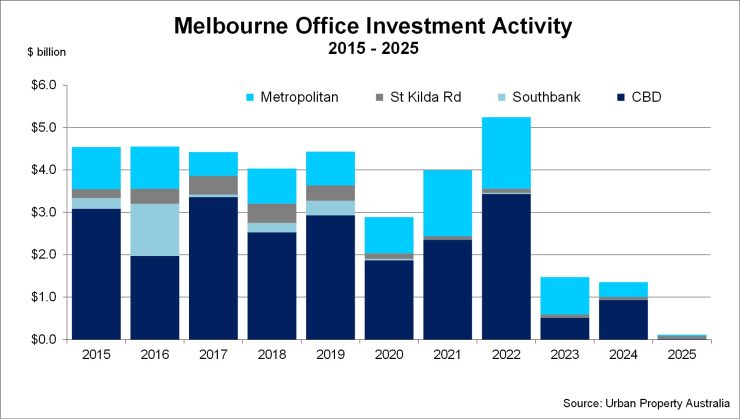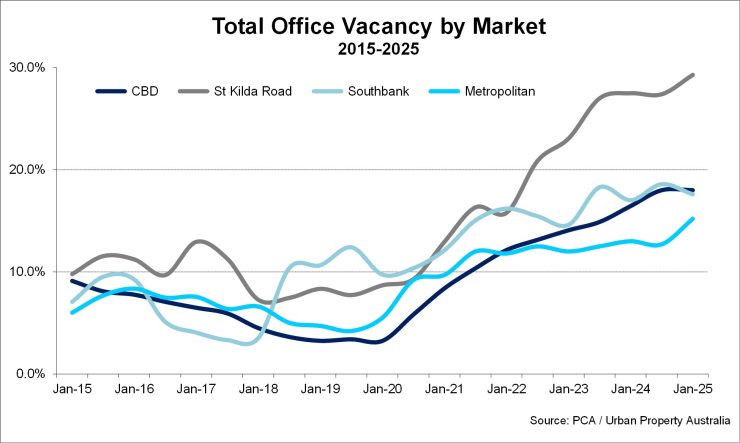Q1 2025 – Melbourne Office Market
April 26th 2025 | , Urban Property Australia
- Transactional activity in Melbourne’s office market has been subdued with limited sales recorded in 2025 to date with only $114 million of Melbourne offices sold;
- Of the 95,000 square metres of new office projects currently under construction in the metropolitan office market, only 21% is already committed with the City Fringe accounting for 71% of all new metropolitan office stock;
- With tenant demand subdued, the Melbourne metropolitan office market vacancy rate remains elevated at 15.2% more than double the long-term average.
Office Market Summary
The vacancy rate of the Melbourne CBD office market remains stable at its highest rate since 1997 with St Kilda Road office market’s vacancy rate at its highest level on record and the vacancy rate of the Southbank office market almost double its 10-year average. Tenant enquiry remains subdued, with occupiers cautious in the ongoing uncertain economic conditions and structural impacts of remote work despite increasing employers’ preference to have employees working more in offices. Tenant demand remains focused on prime quality offices to attract employees physically back into offices.
Sales Volume/Yields
As has been the case for the past three years, transactional activity in Melbourne’s office market has been subdued with limited sales recorded in 2025 to date. Over the first quarter of 2025, only $114 million of Melbourne offices have been sold, lower than the sales recorded in the first quarter of last year. Based on the volume of sales recorded in the first quarter, the Melbourne office market is on track for its lowest annual level of sales in 20 years. The vast majority of sales recorded in 2025 to date were outside of the CBD and in the Metropolitan market, accounting for 30% of all of Melbourne’s office transactional volume. Reflecting the cautious investor environment on the state of the CBD office market, less than $20 million of CBD office stock has been transacted in 2025 to date and similar to the broader market may be set for the lowest volume of sales in 20 years. Given the limited sales volume and continuing uncertainty on the sector, average prime metropolitan office yields have risen to 7.5% with secondary yields averaging 9.15%. Urban Property expects Melbourne office yields are nearing their peaks however the spread between secondary assets is likely to continue to widen.

Supply
Urban Property is currently tracking 95,000 square metres of new office projects currently under construction in the metropolitan office market. Of all the total stock currently under construction in the metropolitan office market, only 21% is already committed. Much of the focus of the new development remains focused on the City Fringe with the precinct accounting for 71% of all new metropolitan office stock projected to be completed in the next two years. With tenant demand strengthening, albeit still fickle, and the level of new supply peaking in the Melbourne metropolitan office market in the short term, Urban Property projects that while the vacancy rate has peaked, levels are likely to remain elevated as tenants also consider CBD options capitalising on the attractive leasing terms on offer to upgrade their office accommodation. With vacancy levels projected to remain elevated; looking ahead, the development pipeline is forecast to slow as high construction costs and funding requirements are likely to constrain new supply for the medium term.
Tenant Demand
Over the year to March 2025, Victoria’s total employment has increased by 85,000, above the growth of 75,000 recorded 12 months ago, however the state’s unemployment rate rose to 4.4% as at March 2025, up from 4.1% as at March 2024. A similar trend was observed in the job market with 45,200 jobs advertised in Victoria as at March 2025, down from 58,400 a year earlier, with current levels now below the 10-year average of 48,800. Tenant enquiry was similarly subdued, with tenants cautious in the ongoing uncertain economic conditions and structural impacts of remote work despite increasing employers’ preference to have employees working more in offices. Tenant demand remains focused on prime quality offices offering modern amenities and high energy efficiency credentials to mitigate elevated energy costs with secondary assets of limited interest.
Vacancy/Rents
With tenant demand subdued, the Melbourne metropolitan office market vacancy rate remains elevated despite the declining development pipeline. The vacancy rate of the Melbourne metropolitan office market rose slightly, increasing to 15.2% as at January 2025, more than double the long-term average. Urban Property forecast that the vacancy rate of the metropolitan office has peaked for the short term as the pipeline of new supply reduces in coming years. Although the vacancy rate has stabilised, as tenants have increasingly become more cautious, prime rents face downward pressure as tenants explore alternative markets. Over the 12 months to January 2025, prime metropolitan office rents marginally increased while secondary metropolitan office rents declined marginally over the year. Looking ahead, Urban Property Australia forecasts that prime rents have stabilised for the short term with tenant demand subdued. In contrast, secondary office rents are projected to decline even more as occupiers seek to capitalise on better quality space which is highlighted from the recent trend of tenant moves.
CBD, St Kilda Road & Southbank Office Markets
The vacancy rate of the Melbourne CBD office market was steady over the six months to January 2025, as stock withdrawals aided the negative net absorption. According to the Property Council of Australia, the total Melbourne CBD office vacancy rate remained stable at 18.0% as at January 2025, albeit its highest rate since 1997. In comparison to the other Australian CBD office markets, Melbourne’s vacancy is higher than all other markets with Sydney’s CBD vacancy rate sitting at 12.8% and Brisbane at 10.2%. According to the PCA, the Melbourne CBD office market recorded negative net absorption of 44,962 square metres in the six months to January 2025, the fifth consecutive negative period of net absorption. Although tenant demand in the Melbourne CBD office market remained subdued due to economic uncertainty and the impact of hybrid work patterns, there has been an evident increase of tenants relocating or expanding into the CBD. In the six months to January 2025, B-grade office stock outperformed all other grades in the Melbourne CBD with Premium-grade, A-grade and C-grade offices all recording negative net absorption in the six months to January 2025. Prime net effective office rents marginally increased over the year to January 2025 however competition amongst owners which has pushed prime incentives to historical high levels. Reflecting the number of prime office vacant opportunities and competition for tenants, secondary net effective rents have declined through the 12 months to January 2025.

Outside of the CBD, the vacancy rate of the St Kilda Road office market increased in the six months to January 2025, to 29.3%, its highest level on record . Elsewhere the vacancy rate of the Southbank office market decreased to 17.6% as at January 2025, but still almost double its 10-year average. Although the vacancy rates of both the St Kilda Road and Southbank’s office markets are elevated; Urban Property Australia anticipates the completion of the Anzac railway station in September and the completion of the rejuvenation project of Southbank Boulevard will stimulate tenant demand for both markets in the medium term. Like Melbourne’s other office markets, transactional activity remains relatively subdued in both Southbank and St Kilda Road office markets with only two offices sold for more than $10 million across the two office markets with sales volume totalling almost $70 million in 2025 to date.
Copyright © 2025 by Urban Property Australia All rights reserved. No part of this publication may be reproduced in any form, by microfilm, xerography, electronically or otherwise, or incorporated into any information retrieval system, without the written permission of the copyright owner.



